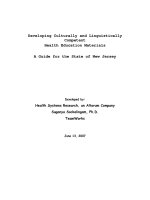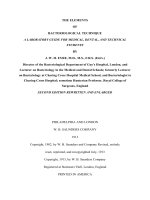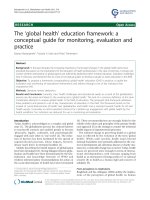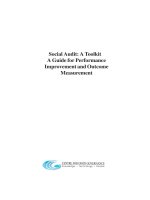The purchasing handbook a guide for the purchasing and supply professional 6th edition
Bạn đang xem bản rút gọn của tài liệu. Xem và tải ngay bản đầy đủ của tài liệu tại đây (10.99 MB, 1,097 trang )
THE PURCHASING
HANDBOOK
A Guide for the Purchasing and
Supply Professional
SIXTH EDITION
JOSEPH L. CAVINATO, Ph.D., C.P.M.
RALPH G. KAUFFMAN, Ph.D., C.P.M.
EDITORS IN CHIEF
Sponsored by the National Association of Purchasing Management
Contact NAPM at P.O. Box 22160, Tempe, Arizona 85285-2160
800/888-6276, fax: 480/752-7890, Web site: www.napm.org
abc
McGraw-Hill
Copyright © 2000 by The McGraw-Hill Companies. All rights reserved. Manufactured in the United States of America. Except as
permitted under the United States Copyright Act of 1976, no part of this publication may be reproduced or distributed in any form
or by any means, or stored in a database or retrieval system, without the prior written permission of the publisher.
0-07-139548-2
The material in this eBook also appears in the print version of this title: 0-07-134526-4.
All trademarks are trademarks of their respective owners. Rather than put a trademark symbol after every occurrence of a trademarked name, we use names in an editorial fashion only, and to the benefit of the trademark owner, with no intention of
infringement of the trademark. Where such designations appear in this book, they have been printed with initial caps.
McGraw-Hill eBooks are available at special quantity discounts to use as premiums and sales promotions, or for use in corporate training programs. For more information, please contact George Hoare, Special Sales, at
or (212) 904-4069.
TERMS OF USE
This is a copyrighted work and The McGraw-Hill Companies, Inc. (“McGraw-Hill”) and its licensors reserve all rights in and
to the work. Use of this work is subject to these terms. Except as permitted under the Copyright Act of 1976 and the right to
store and retrieve one copy of the work, you may not decompile, disassemble, reverse engineer, reproduce, modify, create derivative works based upon, transmit, distribute, disseminate, sell, publish or sublicense the work or any part of it without McGrawHill’s prior consent. You may use the work for your own noncommercial and personal use; any other use of the work is strictly
prohibited. Your right to use the work may be terminated if you fail to comply with these terms.
THE WORK IS PROVIDED “AS IS”. McGRAW-HILL AND ITS LICENSORS MAKE NO GUARANTEES OR WARRANTIES AS TO THE ACCURACY, ADEQUACY OR COMPLETENESS OF OR RESULTS TO BE OBTAINED FROM
USING THE WORK, INCLUDING ANY INFORMATION THAT CAN BE ACCESSED THROUGH THE WORK VIA
HYPERLINK OR OTHERWISE, AND EXPRESSLY DISCLAIM ANY WARRANTY, EXPRESS OR IMPLIED, INCLUDING BUT NOT LIMITED TO IMPLIED WARRANTIES OF MERCHANTABILITY OR FITNESS FOR A PARTICULAR
PURPOSE. McGraw-Hill and its licensors do not warrant or guarantee that the functions contained in the work will meet your
requirements or that its operation will be uninterrupted or error free. Neither McGraw-Hill nor its licensors shall be liable to you
or anyone else for any inaccuracy, error or omission, regardless of cause, in the work or for any damages resulting therefrom.
McGraw-Hill has no responsibility for the content of any information accessed through the work. Under no circumstances shall
McGraw-Hill and/or its licensors be liable for any indirect, incidental, special, punitive, consequential or similar damages that
result from the use of or inability to use the work, even if any of them has been advised of the possibility of such damages. This
limitation of liability shall apply to any claim or cause whatsoever whether such claim or cause arises in contract, tort or otherwise.
DOI: 10.1036/0071395482
Copyright Page
The following chapters are copyrighted by the contributor, and as such no part of these
chapters may be reproduced or distributed in any form or by any means, or stored in a
database or retrieval system, without the prior written permission of the contributor.
Chapter 2—‘‘Creating Supply Advantage by Leveraging the Strategic Nature of
Procurement’’
Chapter 19—‘‘Supplier Price and Cost Analysis’’
Chapter 32—‘‘Purchase of Raw Materials and Commodities’’
Chapter 34—‘‘Software and Intellectual Property’’
This page intentionally left blank.
C O N T E N T S
Contributors
Preface xiii
PART ONE
ix
THE STRATEGIC CONTRIBUTIONS OF
PURCHASING AND SUPPLY
Introduction 1
Chapter 1
The Future of Purchasing and Supply 3
Chapter 2
Creating Supply Advantage by Leveraging the Strategic
Nature of Procurement 35
Chapter 3
Purchasing in the New Firm of the Future 61
PART TWO
THE STRATEGIC APPROACHES OF
PURCHASING AND SUPPLY
Introduction 79
Chapter 4
Development of Supply Strategies 81
Chapter 5
Knowledge of Supply Markets 99
Chapter 6
Purchasing as Relationship Management 127
Chapter 7
Introduction to Supply Chain Management 145
v
Copyright 2000 The McGraw-Hill Companies, Inc. Click Here for Terms of Use.
Contents
vi
Chapter 8
Strategic Alliances and Partnerships 167
Chapter 9
Global Procurement Synergies 205
Chapter 10
Challenges of Outsourcing in Supply Chain Procurement:
How Best to Cope with the Changing Opportunities 221
Chapter 11
Identification and Evaluation of Sources 235
PART THREE
ORGANIZATION AND COMPETENCIES OF
PURCHASING AND SUPPLY
Introduction 277
Chapter 12
Competencies and Skills in Today’s Purchasing 279
Chapter 13
Developing a Purchasing Organization 291
Chapter 14
Re-engineering Purchasing and Supply 311
Chapter 15
Human Resource Management 331
Chapter 16
Purchasing Performance Evaluation 357
Chapter 17
Ethics and Responsibility 375
PART FOUR
COMPONENTS AND CAPABILITIES
Introduction 409
Contents
Chapter 18
Electronic Opportunities and Electronic Commerce—
New Technologies for Purchasing 411
Chapter 19
Supplier Price and Cost Analysis 437
Chapter 20
Total Cost of Ownership 485
Chapter 21
Purchasing and Supply Negotiations 499
Chapter 22
Contract and Subcontract Administration and Management
527
Chapter 23
Quality Assurance 553
Chapter 24
Value Analysis 585
Chapter 25
A Practitioner’s Guide to Forecasting 607
Chapter 26
Inventory Management 641
Chapter 27
Legal Aspects of Purchasing 665
Chapter 28
Investment Recovery 703
Chapter 29
Managing Budgets and Operations 741
Chapter 30
Marketing Purchasing and Supply 755
vii
Contents
viii
Chapter 31
Supplier Performance Evaluation 779
PART FIVE
ITEM AND INDUSTRY PRACTICE
Introduction 807
Chapter 32
Purchase of Raw Materials and Commodities 809
Chapter 33
MRO Materials 833
Chapter 34
Software and Intellectual Property 855
Chapter 35
Capital and Its Impact on the Organization 881
Chapter 36
Services and Nontraditional Goods 925
Chapter 37
Construction Services Procurement 939
Chapter 38
Transportation and Related Services 963
Chapter 39
Purchasing in the Service Industry 993
Chapter 40
Purchasing and Supply Management in the Process and
Extractive Industries 1015
Chapter 41
Public/Private Purchasing 1029
PART SIX
Index
PURCHASING AND SUPPLY INFORMATION
RESOURCES 1071
1075
C O N T R I B U T O R S
Mir F. Ali, MBA, Ph.D. Managing Director, AIM/AMC Corporation,
Las Vegas, Nevada (CHAP. 23)
Richard Antus, CMIR
ving, Texas (CHAP. 28)
Manager, Investment Recovery, GTE Supply, Ir-
William Atkinson Freelance Writer, Carterville, Illinois (CHAP. 3)
Jack Barry
33)
President, E-time, Inc., Fairfield, Connecticut (CHAPS. 10 and
William Boan, CMIR Clinton, Missouri (CHAP. 28)
Ron Brooks, CMIR Central Zone Manager, Weyerhaeuser Company,
Hot Springs, Arkansas (CHAP. 28)
Martin J. Carrara, J.D., C.P.M. Attorney, Staten Island, New York
(CHAP. 27)
Joseph R. Carter, D.B.A., C.P.M. NAPM Professor and Chair of the
Supply Chain Management Department, Arizona State University,
Tempe, Arizona (CHAP. 4)
Lawrence J. Clark, C.P.M. Purchasing Manager, Burleigh Instruments,
Fishers, New York (CHAP. 24)
Gary Colgrove Manager of Resource Recovery, 3M Company, St. Paul,
Minnesota (CHAP. 28)
Thomas A. Crimi Supply Chain Team Coordinator, Texaco, Inc., Houston, Texas (CHAP. 40)
Richard Cuniberti, C.P.M., CMIR Supply Manager, Resource Recovery
and Ecology Services, BASF Corporation, Mount Olive, New Jersey
(CHAP. 28)
Constance Cushman, J.D., C.P.M. Attorney, New York, New York
(CHAP. 27)
Ed Dauginas Director of Purchasing, Raw Materials, Unilever Home
and Personal Care USA, Trumbull, Connecticut (CHAP. 9)
ix
Copyright 2000 The McGraw-Hill Companies, Inc. Click Here for Terms of Use.
x
Contributors
Thomas M. De Paoli, Ph.D., C.P.M., SPHR Principal, Apollo Solutions
Consulting, Apollo Solutions, Sheboygan, Wisconsin (CHAP. 14)
Lisa M. Ellram, Ph.D., C.P.M., A.P.P., CPA, C.M.A. Associate Professor
of Supply Chain Management, College of Business, Arizona State University, Tempe, Arizona (CHAP. 20)
M. Theodore Farris II, Ph.D., C.T.L. Faculty, University of North Texas,
Denton, Texas (CHAP. 38)
Donavon J. Favre Associate Partner, Global Supply Chain Management
Practice, Andersen Consulting, Cleveland, Ohio (CHAP. 1)
Henry F. Garcia, C.P.M. Director of Administration, Center for Nuclear
Waste Regulatory Analyses, San Antonio, Texas (CHAPS. 29 and 36)
Larry C. Giunipero, Ph.D., C.P.M. NAPM Professor of Purchasing and
Supply Management, Florida State University, Tallahassee, Florida
(CHAP. 11)
Frank Haluch, C.P.M. President, Haluch & Associates Ltd., Trumbull,
Connecticut (CHAPS. 19 and 32)
Mary Lu Harding, C.P.M., CPIM, CIRM Consultant, Harding & Associates, Bristol, Vermont (CHAP. 31)
Michael Harding, C.P.M., CPIM Consultant, Harding & Associates,
Bristol, Vermont (CHAP. 31)
Carolyn Jackson, CMIR
fornia (CHAP. 28)
ARCO Western Energy Company, Taft, Cali-
Steve Kesinger, C.P.M., A.P.P. President, The Kesinger Group, Katy,
Texas (CHAP. 6)
Dennis Knutz, CMIR, ASA Director, Investment Recovery, Weyerhaeuser Company, Tacoma, Washington (CHAP. 28)
Roland Kotcamp, C.P.M., CMIR Director, Niagara Mohawk Power
Corporation, Liverpool, New York (CHAP. 28)
Brian G. Long, Ph.D., C.P.M. President, Marketing and Management
Institute, Inc., Kalamazoo, Michigan (CHAP. 21)
Arnold J. Lovering, J.D., C.P.M. Director, Supply Chain Management,
Raytheon Company, Lexington, Massachusetts (CHAP. 17)
Jane Male, CAE Executive Director, The Investment Recovery Association, Mission, Kansas (CHAP. 28)
Contributors
xi
Leslie S. Marell Attorney at Law, Law Offices of Leslie S. Marell, Hermosa Beach, California (CHAP. 34)
William J. Markham Principal, Global Strategic Sourcing Practice, A.T.
Kearney, Inc., Chicago, Illinois (CHAP. 2)
Deverl Maserang Corporate Director, Routing and Logistics, Pepsi Bottling Group, Somers, New York (CHAP. 38)
Paul A. Matthews Managing Partner, Global Supply Chain Management Practice, Andersen Consulting, Wellesley, Massachusetts (CHAP. 1)
Mark S. Miller, C.P.M., CIRM Manager, Materials Control, Case Corporation, Racine, Wisconsin (CHAP. 26)
Jose´ T. Morales Vice President, A.T. Kearney, Inc., Chicago, Illinois
(CHAP. 2)
Michael P. Niemira Vice President and Senior Economist, Bank of
Tokyo-Mitsubishi, Ltd. Research Department and Adjunct Professor of
Economics, Stern School of Business, New York University, New York,
New York (CHAP. 25)
Robert A. Novack, Ph.D. Associate Professor of Business Logistics, The
Pennsylvania State University, State College, Pennsylvania (CHAP. 7)
James T. Parker, C.P.M. Director of Purchasing, University of Utah, Salt
Lake City, Utah (CHAP. 18)
Terrance L. Pohlen, Ph.D. Assistant Professor of Business Logistics,
College of Business Administration, University of North Florida, Jacksonville, Florida (CHAP. 38)
Michael Rhodes, CMIR Corporate Investment Recovery, Virginia Electric & Power Company, Richmond, Virginia (CHAP. 28)
Thomas H. Slaight Vice President, A.T. Kearney, Inc., Chicago, Illinois
(CHAP. 2)
Linda L. Stanley, Ph.D. Associate Professor, School of Business, Our
Lady of the Lake University, San Antonio, Texas (CHAP. 16)
James Tognazzini Facility and Operations Manager, UPS Worldwide
Logistics, Irving, Texas (CHAP. 38)
Richard J. Toole Associate Partner, Global Supply Chain Management
Practice, Andersen Consulting, Atlanta, Georgia (CHAP. 1)
xii
Contributors
Robert J. Trent, Ph.D. Associate Professor of Management, Lehigh University, Bethlehem, Pennsylvania (CHAP. 8)
Virginia M. Tucker, Ph.D. Associate Dean for Executive Education and
Associate Professor of Business Administration, The Pennsylvania State
University, State College, Pennsylvania (CHAP. 12)
Roland R. Tunez Director–Supply Chain Management, Network Purchasing Team, BellSouth Telecommunications, Inc., Atlanta, Georgia
(CHAP. 13)
Elaine N. Whittington, C.P.M., A.P.P., CPCM Educator, G & E Enterprises, Sunland, California (CHAP. 22)
Alvin J. Williams, Ph.D. Chair and Professor, Department of Management and Marketing, University of Southern Mississippi, Hattiesburg,
Mississippi (CHAP. 30)
Donald L. Woods, J.D., C.P.M. State and Local Government Consultant, Las Vegas, Nevada (CHAP. 41)
Bruce J. Wright President, B. Wright & Associates and Total Systems,
Inc., Midvale, Utah (CHAPS. 35 and 37)
Joseph A. Yacura Senior Vice President, Worldwide Procurement,
American Express, New York, New York (CHAP. 39)
Rene A. Yates, C.P.M. Director of Materials, B.A. Ballou & Company,
Inc., East Providence, Rhode Island (CHAP. 15)
William Yerkey General Manager, Investment Recovery, Union Carbide Corporation, South Charleston, West Virginia (CHAP. 28)
Richard R. Young, Ph.D., C.P.M. Assistant Professor of Business Administration, Academic Program Director for Purchasing Continuing Education, The Pennsylvania State University, State College, Pennsylvania
(CHAP. 5)
P R E F A C E
T
he Purchasing Handbook—A Guide for the Purchasing and Supply Professional reflects the field at a milestone in its evolution and sets the tone
for its contributions to organizations for the first five years of the next
millennium. The book builds upon the tradition of the field as reflected
by its long history from its first publication in the 1920s. But unlike previous editions, which captured the field’s state of the art at a moment in
time, this edition has a future orientation that assists the reader in preparing for newly demanded processes, skills, and systems. This edition
contains contributions from field leaders that point to a new direction of
‘‘supply’’ that is in addition to the traditional buying role in the firm.
This edition parallels the National Association of Purchasing Management’s (NAPM) change and shift forward as it continues to identify how
the world of purchasing and supply is changing and prepares its membership to attain the levels of contributions now demanded of it.
Many new topics and much new material are included in this edition. Purchasing as a strategic activity blended with that of the firm or
organization is contained within Part 1. This is followed by chapters
devoted to marketplace intelligence, purchasing as relationship management, electronic systems and e-business opportunities, outsourcing/insourcing, supply, and the need to market purchasing and supply within
the firm.
Several chapters are updates of concepts that have been evolving
during the 1990s. Re-engineering, outsourcing, total cost of ownership,
and others are now accepted parts of the field. Each chapter on these
evolving topics contributes new material for the benefit of readers in
their careers and in their roles in their organizations.
The book also provides a solid base of updated material of the
field’s core concepts. These include, but are not limited to, such topics
as MRO, contracting, forecasting, inventory management, legal aspects,
and budgeting. Together, these build a showcase of the field’s state of
practice.
We would like to give hearty thanks to each of the authors for their
contributions to this edition and the field; to their employers, countless
co-workers, family members, and friends who no doubt served as readers, proofreaders, and sounding boards; and lastly, to those persons in
xiii
Copyright 2000 The McGraw-Hill Companies, Inc. Click Here for Terms of Use.
xiv
Preface
the lives of the authors who no doubt endured weekends and evenings
without the benefit of their company while they toiled to develop and
write their chapters. Thank you, all.
Joseph L. Cavinato, Ph.D., C.P.M.
Ralph G. Kauffman, Ph.D., C.P.M.
P A R T
O N E
The Strategic
Contributions of
Purchasing and Supply
Purchasing and supply affects the strategic capabilities of the organization in many ways. Where in the past many viewed it as a standalone
function, it is now seen as a set of value-adding processes that link directly to the market and the organization’s ability to innovate and deliver
value in the marketplace.
The new presence of major consulting firms is one of the hallmarks
of the growth and evolution of the field. This stems from senior managements who now recognize the importance of each expenditure and
related impacts and opportunities of purchasing and supply upon their
organizations. The major consulting firms have the scale and breadth of
scope to develop insights on strategic and macro levels. The three chapters in this section set the stage for the field from the top of the organization.
Chapter 1 presents concepts and viewpoints on the evolution of the
economy, firms and organizations generally, and how purchasing and
supply fits in them specifically. Chapter 2 takes a closer look at how
purchasing can be a contributor within the organization. Chapter 3
bridges the conceptual future to the practicing present. It is the overview
of an extensive scan of the business environment and the senior levels
of purchasing with a reporting of how the field is expected to change
within the next five years.
1
Copyright 2000 The McGraw-Hill Companies, Inc. Click Here for Terms of Use.
This page intentionally left blank.
C H A P T E R
1
The Future of Purchasing
and Supply
Editor
Paul A. Matthews
Managing Partner
Global Supply Chain Management Practice
Andersen Consulting
Associate Editors
Richard J. Toole
Associate Partner
Global Supply Chain Management Practice
Andersen Consulting
Donavon J. Favre
Associate Partner
Global Supply Chain Management Practice
Andersen Consulting
Trying to predict the future of procurement? Take a number.
Between eProcurement, global sourcing, electronic catalogs, strategic alliances, and supply chain integration, today’s procurement professional, just to survive, had better be part Internet guru, part strategy
consultant, and part world geography professor. But amid the buzzwords, the articles, and the ‘‘experts’ ’’ prognostications, one fact is clear:
the procurement function continues to grow in importance and complexity. As world markets open to new sourcing networks and
companies learn to link critical business functions across enterprises, the
procurement process will become a primary element of any successful
company’s competitive strategy.
This chapter addresses several of the most important changes that
practitioners struggle with, including developing a coherent procurement strategy, understanding and using new technology, structuring a
procurement organization for maximum impact, and more tightly integrating suppliers. Relevant to each of these four topics, however, are the
underlying trends causing these changes.
3
Copyright 2000 The McGraw-Hill Companies, Inc. Click Here for Terms of Use.
4
PART 1
The Strategic Contributions of Purchasing and Supply
INDUSTRY TRENDS—HOW WILL THEY
IMPACT PROCUREMENT?
While the possible combinations and permutations of procurement’s future path are endless, four key trends appear most likely to fundamentally shape tomorrow’s procurement practices: Globalization, Industry
Consolidation, Technology Advancements, and Supply Chain Synchronization.
Globalization
Globalization is revolutionizing the scope of the procurement function.
Initially, sourcing across borders was a defensive tactic to maintain competitiveness by reducing cost in response to foreign entrants who were
penetrating domestic markets. However, forward-looking companies
now recognize international supply management as a key driver of financial performance and overall competitiveness. Companies with global
sourcing capabilities seek to reduce costs, improve quality and flexibility,
and enter markets faster.
Political, social, economic, and technological factors have all contributed to the development of an open, global marketplace. Multinational firms are no longer riveted on local operations, but are synchronizing disparate divisions and geographies to create formidable leverage.
Smaller companies that lack significant influence alone are joining ranks
to form purchasing consortiums and buying clubs. The impact of globalization on the United States is evident in the rise in imports from $40
billion in 1970 to an astounding $1,048 billion in 1997.1
As companies turn from domestic to global sources of supply, procurement professionals must be cognizant of both the opportunities and
the threats when constructing an international sourcing strategy. Companies that fail to pay attention to the risks associated with global sourcing will lose the anticipated benefits, while more astute organizations
will execute procurement strategies that mitigate risk and enhance value.
Just as an investor purchases a diversified portfolio of financial instruments, a global sourcing strategist can insulate a firm from adverse conditions by leveraging the global supply market.
Understanding world markets can be difficult, since each country
is both unique and complex. In order to develop and manage the optimal
1. U.S. Census Bureau, on-line balance of trade statistics
CHAPTER 1
The Future of Purchasing and Supply
5
portfolio, procurement professionals must understand the key drivers
shaping the global purchasing industry: politics, infrastructure, currency,
climate, and culture.
Politics
A country’s government can have dire and dramatic influence on global
sourcing. It controls the movement of goods through tariffs and trade
agreements, and political unrest or imposed trade embargoes can cause
sudden interruptions in supply. Ocean Spray Cranberries, a leading beverage manufacturer, realized the impact of political chaos when Bosnia
erupted in civil war and OSC’s main supply of raspberry concentrate
dried up virtually overnight. As prices skyrocketed, OSC quickly sought
out alternative sources in Latin and South America.
Procurement professionals should monitor the political climate to
avoid disastrous situations. Enron’s Dabhol Power Project in Maharashtra, India, is a well-documented example of a company that failed to
consider the political environment before entering an emerging market.
In the early 1990s, Enron attempted to enter the power market in India,
an industry that was in the process of being privatized. When the government suddenly changed hands, the project was cancelled. Enron is
still recovering from this mishap.2
Governments’ regulating bodies also exert tremendous influence
over offshore purchasing relationships. Labor laws, health and safety
standards, and environmental compliance are just some of the factors to
weigh in devising an international sourcing strategy. Not only can regulations have a tremendous impact on the cost of doing business, but
failure to comply can have dire public relations and legal consequences.
For instance, environmental legislation in Western Europe requires companies to manage waste generation and disposal throughout the entire
product lifespan.
Infrastructure
Closely linked to a country’s political system is its financial, physical,
and technological infrastructure. The global economy is presently experiencing its worst crisis since World War II. The world’s second-largest
economy, Japan, is in financial turmoil, nearly crippled by a severe credit
2. ‘‘Enron Development Corp: The Dabhol Power Project in Maharashtra, India,’’ Harvard
Business School Publications, July 6, 1998.
6
PART 1
The Strategic Contributions of Purchasing and Supply
crunch and recession. The Japanese banking system has lost almost all
its true capital and cannot lend,3 while emerging economies such as Russia, Malaysia, and South Korea are on the verge of dropping out of the
global economy. These unstable financial systems increase the risk of
offshore sourcing. As the economy becomes increasingly global, the linkages and interdependencies across countries will continue to rise.
Other aspects of a country’s infrastructure also matter. From the
quality of the road systems to access to ports, physical attributes will
dictate the feasibility of tapping a particular source. Beyond the transportation system, another key infrastructure issue is the country’s communications network. Quality of telephone systems, speed of modem
connections, and access to both digital and analog lines should be evaluated. Additionally, the information technology capabilities of individual
suppliers may be generations behind the information systems infrastructure that supports corporate headquarters, further complicating the ability to interface and communicate. While these shortcomings may not
represent significant barriers, the increased cost, time, and complexity of
working with inferior infrastructures must be assessed and managed accordingly.
Currency
Managing a global supply network exposes companies to fluctuations in
foreign currency exchange rates. The futures market for foreign currencies enables companies to hedge themselves and mitigate exchange rate
risk by locking in exchange rates. These fluctuations can also represent
opportunities for companies that have flexible sourcing strategies. For
example, multinational electronics and computer firms in Korea are renewing purchasing contracts with Korean manufacturers, primarily due
to the steep depreciation of the Korean won. Also, the weak Canadian
dollar in conjunction with NAFTA has spurred a tremendous increase in
cross-border purchases. See Figure 1–1.
Perhaps one of the biggest changes in global procurement has been
the creation of the common currency of most of the European Union, the
Euro. Comprised of the currencies from many countries, prices are now
leveling throughout the ‘‘Eurozone,’’ now that they must be stated in the
new Euro as well as the original currency. Buyers can now compare
prices across several countries, and sellers find it difficult to maintain
3. ‘‘Easing the Crisis of the World Economy,’’ The News and Observer (Raleigh, NC), September 20, 1998.
CHAPTER 1
The Future of Purchasing and Supply
F I G U R E
7
1–1
Examples of Currency Fluctuations in the Late 90’s
US Dollar to Brazilian Real
1.2
1.15
1.1
1.05
9/1/98
5/1/98
7/1/98
3/1/98
1/1/98
9/1/97
11/1/97
5/1/97
7/1/97
3/1/97
Dollar to Malaysian Ringgit
1/1/97
1
5
4.5
4
3.5
3
9/1/98
5/1/98
7/1/98
1/1/98
3/1/98
9/1/97
11/1/97
5/1/97
1/1/97
1.6
3/1/97
2
US Dollar to Canadian Dollar
7/1/97
2.5
1.5
1.4
9/1/98
7/1/98
5/1/98
3/1/98
1/1/98
9/1/97
11/1/97
7/1/97
5/1/97
3/1/97
1.2
1/1/97
1.3
different margins for various country markets. In 2002 the local currencies within the Eurozone will disappear and be completely replaced by
the Euro. At the time of this writing the U.K. has elected to remain
outside the Euro, but this might change in a few years.
Climate
Agricultural products are exposed to the uncontrollable factors of
weather and climate. To minimize the risk of depending solely on one
geography, procurement managers purchasing agriculture products
should adopt a strategy of selective global sourcing. For instance, several
leading beverage manufacturers source apple concentrate from three continents to smooth supply disparities driven by uncontrollable events.
This strategy mitigates supply risk and provides increased flexibility to
manage demand fluctuations and cost.
Culture
One of the biggest challenges and risks in terms of global sourcing is
learning to work within cultures that have different languages, customs,
and ethics. Yet it is critical to develop an understanding of a foreign
PART 1
8
The Strategic Contributions of Purchasing and Supply
supplier’s culture prior to establishing a relationship, whether through
cultural coaches, immersion in the new environment, and/or strong relationships with locals who will help avoid the pitfalls. Indeed, language
barriers and improper business etiquette can be a major obstacle to establishing a successful sourcing relationship. Seemingly innocent behavior, such as showing the sole of your shoe to an Arab or rushing into
business conversations in Latin America, have caused countless business
deals to collapse. Cultural mishaps can undermine the ability to conduct
business and develop any trusting relationship.
Industry Consolidation
The corporate motto for the 1990s seemed to be ‘‘bigger is better.’’ Consider the following:
ࡗ
ࡗ
ࡗ
Merger and acquisition activity across all sectors worldwide
totaled more than $1.8 trillion through the first nine months of
1998.4
51 of the largest 100 economies in the world were
corporations.5
The 300 largest corporations accounted for one quarter of the
world’s productive assets.6
Both ‘‘buyers’’ and ‘‘sellers’’ in nearly every major sector have felt
the impact of consolidation. The banking industry alone has experienced
nearly $400 billion worth of consolidation (see Figure 1–2).7 Traditional
supply sectors such as oil and gas, chemicals, and utilities have been
strongly affected. On the ‘‘buyer’’ side, sectors such as telecommunications, insurance, and transportation equipment have experienced significant merger and acquisition activity.
Furthermore, the pace of consolidation is not expected to slow.
Charles Roussel, a partner and director of Andersen Consulting’s Mergers, Acquisitions and Alliances Center of Excellence, expects to see consolidation continue in many sectors. ‘‘Despite almost a decade of reengineering, there is still considerable excess capacity in many markets—
4. A. Lindgren, and T. Tedesco ‘‘Mega-Merger Mania: The Long-Term Implications,’’ The
Vancouver Sun, May 14, 1998.
5. Ibid.
6. Ibid.
7. Ibid.
CHAPTER 1
The Future of Purchasing and Supply
F I G U R E
9
1–2
Value Consolidations by Industry Sector
Commercial Banks, Bank Holding Companies
Telecommunications
Insurance
Radio and Television Broadcasting Stations
Oil and Gas; Petroleum Refining
Business Services
Real Estate; Mortgage Bankers and Brokers
Chemicals and Allied Products
Transportation Equipment
Electric, Gas, and Water Distribution i
Electronic and Electrical Equipment
Food and Kindred Products
$-
$50
$100 $150 $200 $250 $300 $350 $400 $450
pharmaceuticals, paper and pulp, and automotive to name a few. Those
companies with operational savvy and already streamlined cost structures will reap significant competitive advantage by decreasing industry
capacity through selectively acquiring and rationalizing assets in their
target markets.’’8 In fact, some sectors will see the pace of consolidation
increase—particularly industries such as utilities where deregulation will
lead to dramatic competitive change.
Given this frenzy of consolidation activity, and the predictions that
there is no end in sight, how will the procurement function be impacted?
Industry consolidation will lead to greater overall procurement efficiencies as newly formed companies leverage their size and influence
to push suppliers for more services and lower costs. Suppliers will respond through consolidations and strategic alliances of their own.
Through consolidation and/or alliances, tomorrow’s suppliers will offer
a greater breadth of products, cost-cutting technologies, value-added services, and international networks. In return for these new efficiencies and
capabilities, successful suppliers will demand long-term, sole-sourcing
agreements from their customers.
8. Mergers & Acquisition Activity by SIC Code in Rank US$, Securities Data Company, Inc.,
September 22, 1998.
10
PART 1
The Strategic Contributions of Purchasing and Supply
Strategic Alliances
Two fundamental types of strategic alliances will play a role in the procurement strategy of tomorrow: the traditional long-term buyer–seller
alliance and cross-company supplier partnering. Although not new, each
will become an increasingly critical component of the new procurement
landscape. As organizations operate more and more virtually (e.g., Nike,
Sara Lee, Chiron), with numerous alliances in their orbit, the complexity
of their procurement relationships will intensify; at various times, in various relationship configurations. The different parties may all be supplier,
buyer, and customer to one another at some point in the relationship.
The buyer–seller alliance will continue to expand in both scope and
scale. Companies will continue to look for procurement alliances that
leverage suppliers’ skills. Martin Krueger of Blommer Chocolate noted,
‘‘It’s no longer the purchasing agent and the salesperson interacting. It’s
the technical people working together.’’9 Alliances shaped by the improved skill sets of consolidated suppliers—particularly R&D/product
development—will continue to supplant relationships focused strictly on
price.
The airline and aerospace sectors represent an excellent example of
two highly consolidated industries taking strategic buyer/seller alliances
to the next level. The number of worldwide suppliers of large jetliners
has been reduced to a handful—most notably Boeing and Airbus. These
two companies can provide one-stop shopping for jetliners and all associated services and can pursue long-term, sole-sourcing relationships
with their customers. Boeing demonstrated this through their agreements
with several major airlines. Delta, Continental, and American Airlines
have all signed long-term (e.g., 20 years) agreements to purchase all aircraft larger than regional jets from Boeing. The first orders from Continental and Delta represent $10.7 billion worth of business to Boeing.10,11
These long-term alliances illustrate how both buyers and suppliers in
a consolidated industry can derive significant procurement-related
benefits.
The second type of alliance will involve the partnering between
suppliers of complementary products. As buyers continue to consolidate
9. Interview by Charles Roussel, Andersen Consulting, Mergers & Acquisition Center of
Excellence, September 29, 1998.
10. ‘‘Supplier Roundtable Pieces Together the Industry,’’ Candy Industry, May 1998, A2–
A11.
11. Note that Airbus and the EU have challenged the legality of these exclusive contracts.
As such, the commitment to a single provider may not be legally binding.









